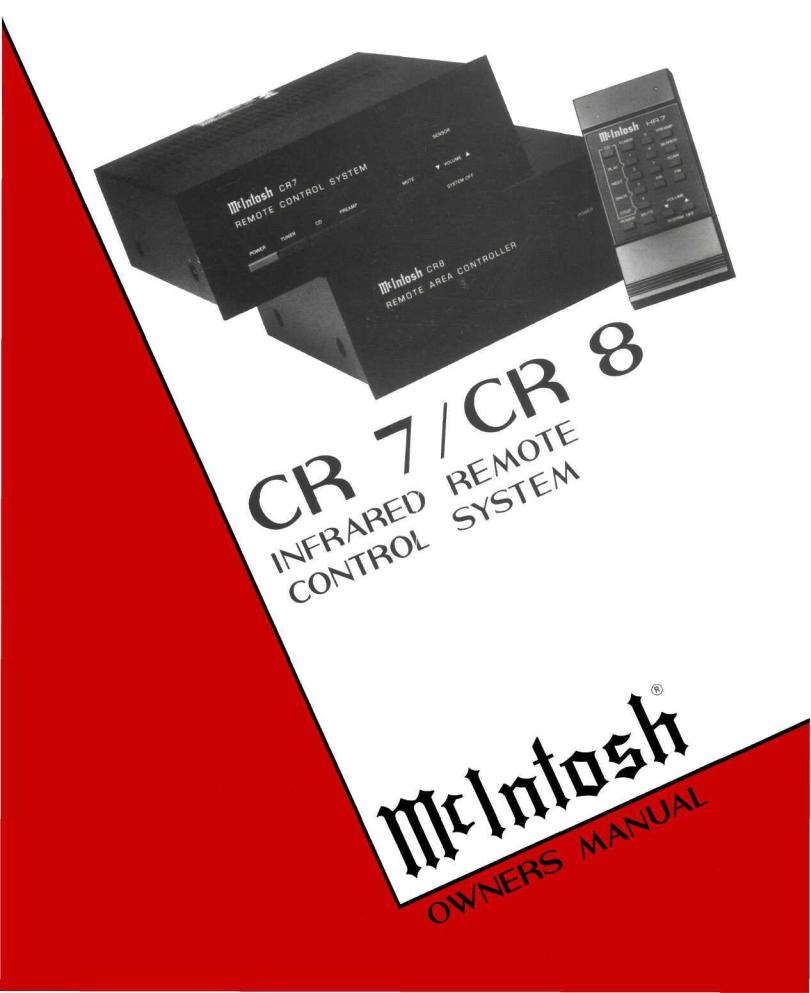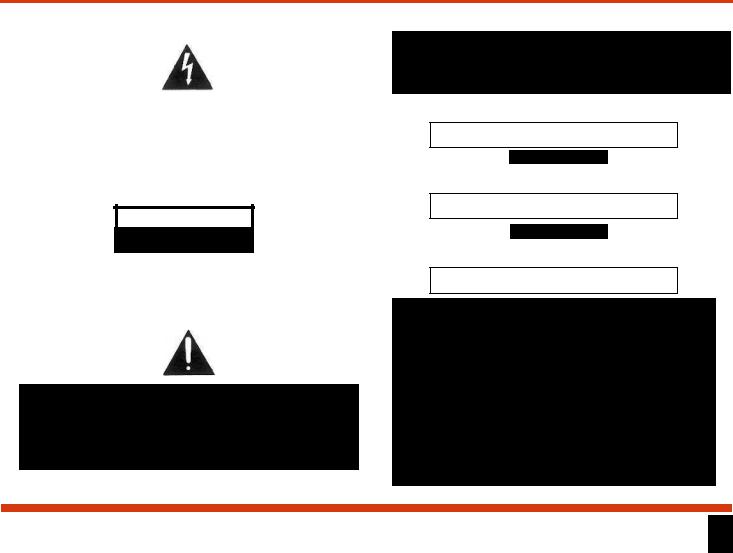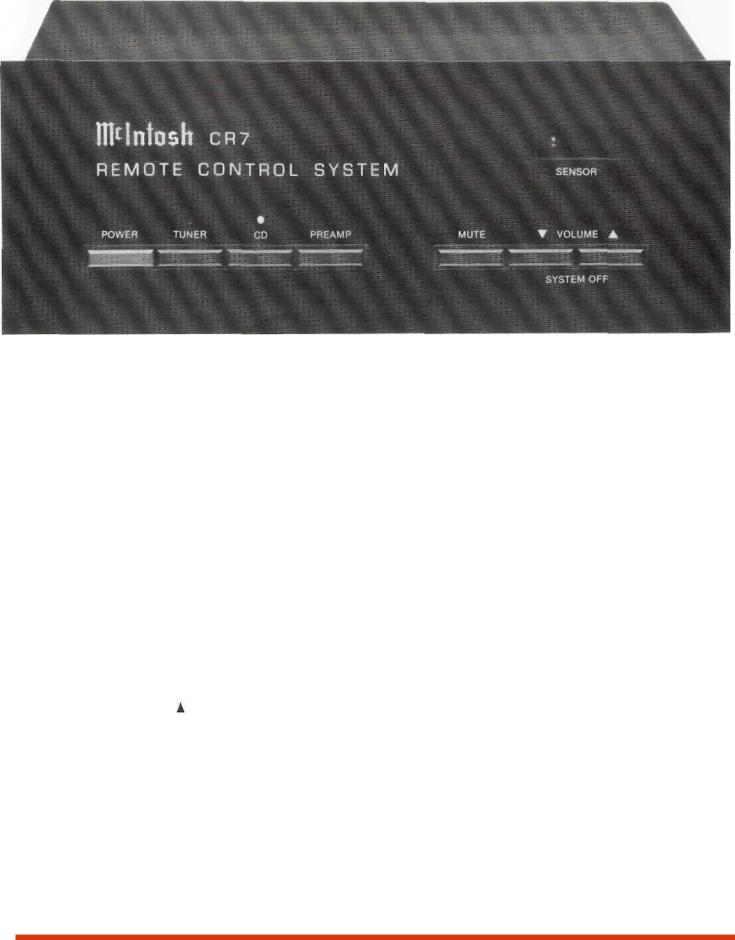McIntosh CR-7, CR-8 Owners manual


IMPORTANT SAFETY INSTRUCTIONS
THESE INSTRUCTIONS ARE TO PROTECT YOU AND THE MclNTOSH INSTRUMENT. BE SURE TO FAMILIARIZE YOURSELF WITH THEM.
1.Read all instructions - Read the safety and operating instructions before operating the instrument.
2.Retain Instructions - Retain the safety and operating instructions for future reference.
3.Heed warnings - Adhere to warnings and operating instructions.
4.Follow Instructions - Follow all operating and use instructions.
WARNING: TO REDUCE RISK OF FIRE OR ELECTRICAL SHOCK, DO NOT EXPOSE THIS INSTRUMENT TO RAIN OR MOISTURE.
5.Power Sources - Connect the power supply only to the type described in the operating instructions or as marked on the unit.
6.Power-Cord Protection - Route power-supply cords so that they are not likely to be walked on or pinched by items placed upon or against them, paying particular attention to cords at plugs, convenience receptacles, and the point where they exit from the instrument.
7.Ventilation - Locate the instrument for proper ventilation. For example, the instrument should not be placed on a bed, sofa, rug, or similar surface that may block ventilation openings; or, placed in a built-in installation, such as a bookcase or cabinet,
that may impede the flow of air through the ventilation openings.
8.Heat - Locate the instrument away from heat sources such as radiators, heat registers, stoves, or other appliance (including amplifiers) that produce heat.
9.Wall or Cabinet Mounting - Mount the instrument in a wall or cabinet only as described in the owners manual.
10.Water and Moisture - Do not use the instrument near water - for example, near a bathtub, washbowl, kitchen sink, laundry tub, in a wet basement, or near a swimming pool, etc.
11.Cleaning - Clean the instrument by dusting with a dry cloth. Clean the panel with a cloth moistened with a window cleaner.
12.Object and Liquid Entry - Do not permit objects to fall and liquids to spill into the instrument through enclosure openings.
13.Power Lines - Locate any outdoor antenna away from power lines.
14.Outdoor Antenna Grounding - If an outdoor antenna is connected to the antenna terminal, be sure the antenna system is grounded to provide some protection against voltage surges and built up static charge.
In the U.S.A., section 810 of the National Electrical Code, ANSI/NFPA No. 70-1987, provides information on the proper ground for the mast and supporting structure, ground for the lead-in wire to an antenna discharge unit, and size of ground conductors, location of antenna-discharge unit, connection to grounding electrodes, and requirements
for the grounding electrode. For ground wire:
a)Use No. 10 AWG (5.3 mm2) copper No. 8 AWG (8.4 mm2) aluminum, No. 17 AWG (1.0 mm2)
copper-clad steel, bronze wire, or larger as ground wire.
b)Secure antenna lead-in and ground wires to house with stand-off insulators spaced from 4 feet (1.22 meters) to 6 feet (1.83 meters) apart.
c)Mount antenna discharge unit as closely as possible to where lead-in enters house.
d)Use jumper wire not smaller than No. 6 AWG (13.3 mm2) copper or equivalent when separate antenna grounding electrode is used.

15.Nonuse Periods - Unplug the power cord from the AC power outlet when left unused for a long period of time.
16.Damage Requiring Service - Service must be performed by qualified service personnel when:
A. The power supply cord or the plug has been
damaged; or
B.Objects have fallen, or liquid has been spilled into the instrument; or
C.The instrument has been exposed to rain; or
D.The instrument does not appear to operate normally or exhibits a marked change in performance; or
E.The instrument has been dropped, or the enclosure damaged.
17.Servicing - Do not attempt to service beyond that
described in the operating instructions. All other service should be referred to qualified service personnel.
18.Grounding or Polarization - Do not defeat the inherent design features of the polarized plug. Nonpolarized line cord adaptors will defeat the safely provided by the polarized AC plug.
19.CAUTION: TO PREVENT ELECTRICAL SHOCK DO NOT USE THIS (POLARIZED) PLUG WITH AN EXTENSION CORD, RECEPTACLE OR OTHER OUTLET UNLESS THE BLADES CAN BE FULLY INSERTED TO PREVENT BLADE EXPOSURE.
Note to CATV system installer:
This reminder is provided to call the CATV system installer's attention to Article 820-22 of the NEC that provides guidelines for proper grounding and, in particular, specifies that the cable ground shall be connected to the grounding system of the building, as close to the point of cable entry aspractical.
ATTENTION: POUR PREVENIR LES CHOCS ELECTRIQUES PAS UTILISER CETTE FICHE POLARISEE AVEC UN PROLONCATEUR, UNE PRISE DE COURANT OU UNE AUTRE SORTIE DE COURANT, SAUF SI LES LAMES PEUVENT ETRE INSEREES A FOND SANS EN LAISSER AUCUNE PARTIE A DECOUVERT.
The lightning flash with arrowhead, within an equilateral triangle, is intended to alert the user to the presence of uninsulated "dangerous voltage" within the product's enclosure that may be of sufficient magnitude to constitute a risk of electric shock to persons.
CAUTION
RISK OF ELECTRIC SHOCK
DO NOT OPEN
CAUTION: TO PREVENT THE RISK OF ELECTRIC SHOCK, DO NOT REMOVE COVER (OR BACK). NO USER-SERVICABLE PARTS INSIDE. REFER SERVICING TO QUALIFIED PERSONNEL.
The exclamation point within an equilateral triangle is intended to alert the user to the presence of important operating and maintenance (servicing) instructions in the literature accompanying the appliance.
The serial number, purchase date, and Mclntosh Laboratory Service Contract number are important to you for possible insurance claim or future service. Record this information here.
Serial Number
Purchase Date
Service Contract Number
Upon application, Mclntosh Laboratory provides a Service Contract to the original purchaser. Your Mclntosh Authorized Service Agency can expedite repairs when you present the Service Contract with the instrument.
Copyright MCMLXXXVIII © by Mclntosh Laboratory Inc.

Contents
INTRODUCTION 3 FRONT PANEL 4 HAND HELD REMOTE 5
CONNECTIONS 6, 7, 8, 9 CONNECTIONS 10, 11, 12 CONNECTIONS 13
ACCESSORIES 14 PERFORMANCE LIMITS 15
BLOCK DIAGRAM 16, 17
Take Advantage of 3 Years of
Contract Service. . .
Fill in the Application NOW.
Your CR 7 and CR 8 Remote Control will give you many years of satisfactory performance. If you have any questions, please contact,
CUSTOMER SERVICE
Mclntosh Laboratory Inc.
2 Chambers Street
Binghamton, New York 13903-9990
Phone: 607-723-3512
MclNTOSH THREE YEAR SERVICE CONTRACT
An application tor A THREE YEAR SERVICE CONTRACT is included with this manual.
The terms of the contract are:
I. If the instrument covered by this contract becomes defective, Mclntosh will provide all parts, materials, and labor needed to return the measured performance of the instrument to the original performance limits free of any charge. The service contract does not cover any shipping costs to and from the authorized service agency or the factory.
2. Any Mclntosh authorized service agency will repair all Mclntosh instruments at normal service rates. To receive the free service under the terms of the service contract, the service contract certificate must accompany the instrument when taken to the service agency.
3. Always have service done by a Mclntosh authorized service agency. If the instrument is modified or
damaged as a result of unauthorized repair the service contract will be cancelled. Damage by improper use or mishandling is not covered by the service contract.
4. The service contract is issued to you as the original purchaser. To protect you from misrepresentation this contract cannot be transferred to a second owner.
5. Units in operation outside the United States and Canada are not covered by the Mclntosh Factory Service Contract, irrespective of the place of purchase. Nor are units acquired outside the USA and Canada, the purchasers of which should consult with their dealer to ascertain what, if any, service contract or warranty may be available locally.
2

The Mclntosh infrared Remote Control System provides unusual versatility with operating simplicity. It is a system which provides remote control in one listening area yet can be expanded to provide individual source selection with independent volume settings in up to five additional areas. In each of these areas, when connected to a Mclntosh tuner, designed to connect to the infrared remote control system, and a Mclntosh compact disc player:
1) you can turn on the AC power to the local area or turn off the AC power for the local area only or for all areas;
2)you can select the listening sound source (tuner, compact disc, or preamplifier) for the local area while other areas can choose their listening source independently;
3)you can adjust the volume in the local area and not affect the volume in other areas;
4)when the tuner is the sound source, you can select the stations you wish to hear on either AM or FM and depending on the tuner, scan the preset stations on either AM or FM or search the entire AM or FM band;
5)When the compact disc player is the sound
source, you can put the CD player in the play mode, shift to the next track or the proceeding track on the disc or stop the play from the disc; or
6) you can select the preamplifier as a program source with all of its connected sources.
To illustrate the control versatility of the Mclntosh infrared Remote Control System, with the hand-held remote controller, you can turn on the AC power for that equipment, which feeds program material to a listening area, without turning on the AC power for other areas. While you arc listening to a compact disc in the main area, someone in another area can turn on the AC power for their area and elect to listen to FM. When you are through listening in your area, you can turn off the AC power to your area while the listener in the other area continues to listen to the tuner. Each area can adjust their own volume without affecting the other areas volume. In addition, the AC power to all areas can be turned off by a hand-held controller in any area.
Your listening commands are executed by pressing the selected buttons on the hand-held remote controller. When you press a button the controller transmits, via an infrared beam, a twelve bit command signal. The receiver for these signals is an infrared sensor on the front of the CR 7 remote control module or the Mclntosh R607 Remote Sensor.
Remote sensors are designed to be installed in an electrical switch box for in wall or ceiling installation. Ordinary video distribution cable, RG-59/U, connects the remote sensor to the Mclntosh infrared Control Modules.
The CR8 contains the interconnecting circuits, the remote station data decoder and switch facilities for a second or remote area. The only front panel indicator is a red LED which lights when the remote area AC power is turned on.
INTRODUCTION 3

The touch-buttons on the black anodized aluminum front pane! of the CR7 control AC power to the local area, source selection, system mute and volume. In the upper right is an infrared sensor which receives the control data transmitted by the hand-held remote controller. In addition to the touch-buttons on the CR7, these functions and more, can be initiated by the hand-held remote controller.
POWER
The red POWER touch-button on the CR7 and the POWER button on the remote control turn the AC power on or off to the local area. When AC power is turned on, the system switches automatically to the tuner, with volume set to 40 dB below full volume. The station heard will be the last one tuned when the system was turned off. A green LED above the TUNER touch-button will light. AC power to the local area is turned off when the POWER button on either the hand-held controller or the CR7 is pressed. To turn off AC power in all areas first turn off the AC power locally by pressing POWER followed by pressing both VOLUME and VOLUME simultaneously.
and VOLUME simultaneously.
SOURCE SELECTION
To listen to the compact disc player, the tuner or the preamplifier, touch the corresponding button on the front panel or on the hand-held remote controller. A green LED above the touch-button will light to indicate the source selected.
MUTE
Should you desire to silence the system briefly,
touch the MUTE button on either the CR7 or the remote control. A red LED above the MUTE button will light, and the program will be silenced. To hear the program again, touch the MUTE button a second time. The red LED will go out and the program will be heard.
VOLUME
Volume may be adjusted by using the VOLUME  or VOLUME
or VOLUME  buttons on the front panel or on the remote control. Adjustment of the volume is performed by an electronically switched, precision ladder attenuaior. The Mclntosh electronic precision ladder attenuator adjusts volume by C2 MOS transistor switches that select the right combinations of highly accurate deposits of resistive material. The entire range of volume adjustment is 68 dB in 2 dB increments. Left and right tracking is controlled to a fraction of a dB. Because the volume control doesn't have moving parts, the volume adjustment cannot be misaligned. Unlike ordinary voltage controlled electronic volume controls, the Mclntosh precision ladder attenuator supports the distortion-free, low-noise performance of the Mclntosh products.
buttons on the front panel or on the remote control. Adjustment of the volume is performed by an electronically switched, precision ladder attenuaior. The Mclntosh electronic precision ladder attenuator adjusts volume by C2 MOS transistor switches that select the right combinations of highly accurate deposits of resistive material. The entire range of volume adjustment is 68 dB in 2 dB increments. Left and right tracking is controlled to a fraction of a dB. Because the volume control doesn't have moving parts, the volume adjustment cannot be misaligned. Unlike ordinary voltage controlled electronic volume controls, the Mclntosh precision ladder attenuator supports the distortion-free, low-noise performance of the Mclntosh products.
SENSOR
The infrared sensor is located above the VOLUME buttons. When using the hand-held controller a red LED in the center of the sensor will flash to indicate receiving the transmission.
4 FRONT PANEL
